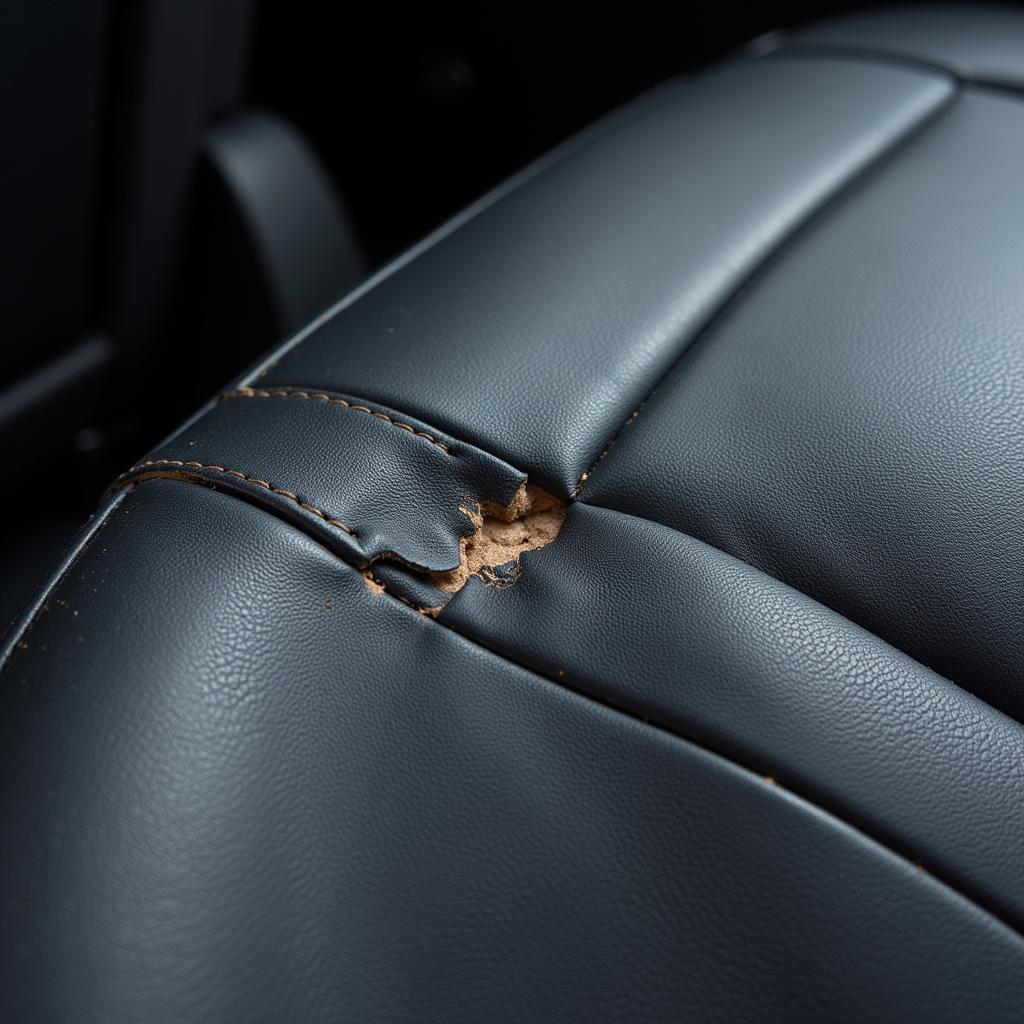Torn leather car seats can be a real eyesore, detracting from the overall aesthetic appeal of your vehicle’s interior. Whether it’s due to wear and tear, sharp objects, or accidents, a ripped car seat can be a frustrating problem. However, fret not! This guide delves into the intricacies of ripped car seat leather repair, providing you with the knowledge and solutions to restore your car’s interior to its former glory.
 Close-up of a ripped leather car seat
Close-up of a ripped leather car seat
Understanding the Extent of the Damage
Before embarking on the repair journey, it’s crucial to assess the severity of the rip. This evaluation will help determine the appropriate repair method and the necessary materials.
- Minor Scratches and Scuffs: These can often be addressed with simple DIY solutions like leather conditioners and dyes.
- Small Tears and Cuts: These may require patching or the use of liquid leather repair kits.
- Large Rips and Extensive Damage: Severe cases might necessitate professional intervention or even seat cover replacements.
DIY Ripped Car Seat Leather Repair Methods
For minor to moderate damage, several do-it-yourself methods can effectively address the issue:
1. Liquid Leather Repair Kits
These kits offer a convenient and relatively straightforward solution for repairing small rips and tears. They typically consist of a leather filler compound, color matching pigments, and application tools.
Steps:
- Clean the damaged area thoroughly.
- Apply the filler compound to the rip, ensuring it fills the gap completely.
- Use the provided color matching pigments to blend the repaired area with the surrounding leather.
how to repair tear in car seat
2. Leather Patching
Patching is a viable option for larger rips that liquid leather fillers can’t adequately address. Leather patches come in various colors and textures, allowing you to find a close match to your car’s upholstery.
Steps:
- Clean the area around the rip and trim any loose threads.
- Cut a leather patch slightly larger than the damaged area.
- Apply leather adhesive to the back of the patch and carefully position it over the rip.
- Use clamps or weights to apply even pressure while the adhesive dries.
3. Sub-Patching
Sub-patching is ideal for reinforcing weak areas or preventing further tearing around an existing rip.
Steps:
- Clean the area and cut a patch of leather or fabric larger than the weakened spot.
- Apply leather adhesive to the back of the patch.
- Position the patch behind the rip, ensuring it provides adequate support to the damaged area.
how to repair a heated cushion for the car seat
When to Seek Professional Help
While DIY methods can be effective for minor to moderate damage, professional help is recommended for:
- Extensive Damage: Large rips, deep cuts, or extensive damage often require specialized tools and expertise.
- Safety Concerns: Damage to structural components or seat belts necessitates professional attention to ensure passenger safety.
- High-End Vehicles: Luxury vehicles with delicate leather interiors benefit from the expertise of professional upholsterers.
“When dealing with high-end vehicles or extensive damage, it’s always best to consult a professional. They have the experience and specialized tools to deliver the best possible results,” advises John Miller, a veteran automotive upholsterer with over 20 years of experience.
Preventing Future Damage
Once you’ve repaired your ripped car seat, proactive measures can help prevent future damage:
- Regular Cleaning: Regularly clean your leather seats with a pH-neutral cleaner and conditioner to prevent drying and cracking.
- Seat Covers: Consider using seat covers to protect your leather seats from spills, UV rays, and everyday wear and tear.
- Avoid Sharp Objects: Be mindful of sharp objects like keys, pens, and tools that can scratch or puncture the leather.
- Pet Barriers: If you frequently travel with pets, invest in a quality pet barrier to protect your seats from claws and teeth.
Conclusion
Ripped car seat leather repair doesn’t have to be a daunting task. By understanding the extent of the damage, exploring DIY methods, and knowing when to seek professional assistance, you can restore your car’s interior to pristine condition. Remember, regular maintenance and preventive measures go a long way in keeping your leather seats looking their best for years to come. For any further assistance or if you require professional help, don’t hesitate to contact us via WhatsApp at +1(641)206-8880 or email us at cardiagtechworkshop@gmail.com. Our team is available 24/7 to assist you.

